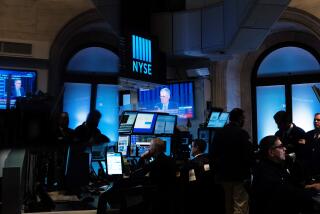It’s not just about double-digit returns
- Share via
How much did your investment nest egg earn in 2006?
And should you feel good or bad about that number?
Many people will confront those questions as they review their portfolios for the year.
After constant warnings from financial pros in the last few years that investors should stop counting on double-digit percentage returns, that’s exactly what the stock market has generated in 2006.
The average domestic stock mutual fund is up 13% this year, according to Morningstar Inc. The average foreign fund is up 24%. Those are the best gains since 2003, the first full year of the current bull market.
Returns on more-conservative investments such as bonds and cash accounts are mostly in the neighborhood of 4% to 7%, according to Lipper Inc.’s mutual fund gauges.
The price of gold is up 19% this year.
If most of your nest egg is in a retirement account such as a 401(k) plan, it may be easy to calculate what your portfolio earned. Some plans do that automatically for you.
Otherwise, you can eyeball your accounts and come up with a guesstimate of an average rate of return. It doesn’t have to be an exact number. The most important benefit of the exercise is in getting a handle on what you have in more aggressive investments compared with what’s in conservative investments, and what each of those two parts of the portfolio is earning.
Knowing your overall portfolio return isn’t all that important when you’re young. For people nearing retirement or in retirement, however, that number becomes much more relevant -- because at that point investment performance may directly affect your quality of life.
That’s true for Louis Barajas’ clients. The Santa Fe Springs-based financial advisor says he has many clients who are retirees with nest eggs worth a few hundred thousand dollars.
“They really figure to live on Social Security and distributions from their portfolio,” Barajas says. So the difference between earning, say, 5% a year versus 10% a year can be quite significant for those folks.
What was a good investment return this year? That depends on your personal circumstances. Here are some things to consider in making that judgment:
* A good return isn’t necessarily an above-average return. The first question to ask in evaluating your returns is, how much risk are you willing to take?
If your risk tolerance is low -- meaning you don’t have the stomach to weather a sharp drop in your assets, even if temporary -- then your portfolio should be structured accordingly. That probably means you should have a big chunk of your money in high-quality bonds, high-dividend stocks, cash accounts or other investments that aren’t likely to decline dramatically in any given period.
If you’ve got a conservative portfolio, your overall return may only be in single digits even in a year like this. But that may still be a good return given your risk tolerance.
Geordie Crossan, president of advisory firm NBS Financial Services in Westlake Village, says the downside of years like this is that some risk-averse investors get starry-eyed about stocks, forgetting how much they hate it when their portfolio loses money.
In the bear market years of 2000, 2001 and 2002, the blue-chip Standard & Poor’s 500 index fell 10%, 13% and 23%, respectively. Some people who thought they could handle losses of that magnitude discovered the pain was too extreme.
Now, in the fifth year of a bull market, “If you’ve been sitting in bank CDs, [this] is not the time to jump on the bandwagon” in stocks in search of higher returns, Crossan warns.
* How much do you need to earn to meet your goals? Look at your 2006 return in the context of the annual average return you’ll need to get where you want to be over time.
Say you plan to retire in 10 years. To calculate the size of the nest egg you’ll need at that point, a financial advisor would ask what kind of lifestyle you want in retirement and what kind of income may be coming in by then from sources such as Social Security.
“What we often see is that people can actually assume less risk than they think they have to take” to meet their objectives, Crossan said.
If earning an average of 7% a year on your nest egg for the next 10 years will give you the lifestyle you want, trying to earn 12% may be unnecessary -- besides putting your portfolio at greater risk of loss in bad market years.
The stock market is flying high now, Barajas says, but another steep decline is out there somewhere. One of the big reasons to keep portfolio volatility manageable via good diversification, he says, is that it will lessen the chance that an investor will want to dump stocks in down years -- at exactly the wrong time.
“If I can keep the volatility down, the client stays in the market,” Barajas says.
* If you’re young, a single-digit return may mean you aren’t taking enough risk. Some people take too much risk. And some should be taking more, given their long-term goals.
For younger people, the best thing about a year like this in the stock market is that it may give them the confidence to be more aggressive for the long haul. It’s a wake-up call for people who have forgotten what stocks can do for a portfolio in a bull market.
Generally, the younger you are, the greater the percentage of your portfolio that should be in stocks -- in good market years and bad.
Over time, the equity market is going to provide your nest egg with growth, Crossan notes. You aren’t going to get that from conservative bonds or cash accounts, even if their interest yields seem reasonably attractive in the short term.
Barajas says he finds that some investors who remember how sharply the stock market fell in 2000-02 are overly conservative in their asset allocation because of it, even though they may have decades of saving ahead of them.
Even older people, he says, should realize that they’re going to need some portion of their assets in stocks to provide growth over time.
A client who is 62, Barajas says, might still need to have about 60% of his assets in stocks, and 40% in bonds and other income-generating investments.
“I’ve got to assume they might live another 30 years,” he says, and that means the portfolio will have to grow, not just generate interest income.
* It’s not what you earn -- it’s what you keep. If most or all of your investments are in tax-deferred accounts, taxes are an issue for later in life. But investors who have money in taxable accounts should think about their after-tax returns as well as their nominal returns.
Case in point: You may be happy earning a 5.5% annualized yield on a 20-year corporate bond. But that interest is subject to federal and state income tax. If you’re in the 32% combined federal and state marginal tax bracket, that 5.5% yield will be 3.7% after tax.
By contrast, you could earn about 4.2% a year, tax free, on a 20-year California general obligation municipal bond.
Likewise, consider the after-tax appeal of cash dividends on common stocks. Dividends are subject to a maximum federal tax rate of just 15%, at least through 2010 under current law.
To put it another way, Uncle Sam lets you keep 85 cents of every $1 you earn in dividends. The state, of course, then takes its cut. Even so, the low federal tax rate on dividends makes them highly attractive for investors who are trying to increase after-tax returns.
*
(BEGIN TEXT OF INFOBOX)
2006 scoreboard
--
Here are average returns this year on some key categories of investments.
--
Foreign stock funds: + 23.9% | Russell 2,000 small stock index: 19.1% | S&P; 500 index: 16.4% | U.S. stock funds: 13.2% | Junk bond funds: +9.5% | California tax-free muni bond funds: + 4.6% | High-quality corporation bond funds: + 4.5% | Money market funds: 4.0% | Government bond funds: 3.6%
--
*Real return is higher, depending on investor’s tax bracket.
-
All returns include dividend or interest income earned.
--
Source: Morningstar, Lipper
More to Read
Inside the business of entertainment
The Wide Shot brings you news, analysis and insights on everything from streaming wars to production — and what it all means for the future.
You may occasionally receive promotional content from the Los Angeles Times.










